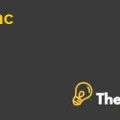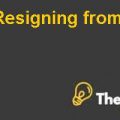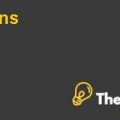
Cartwright Lumber Company
Q1.) Is this company healthy? Construct common size statements for the years 2001 to 2003 based upon sales. Calculate current liabilities, long-term debt, and equity as a percent of assets over the period. Do a ratio analysis using the basic ratios shown in the Cartwright Lumber Company Spreadsheet available on blackboard. Then analyze the income statement and balance sheet from 2001 to 2003 in order to explain what they tell you, but do not make recommendations at this time.
Comparative Income Statement
Analysis of comparative income statement shows that gross profit (GP) margins have increased to 28.16% during the year 2002 from 28% in the year 2001. This represents an increase of 2.15% in gross profit margins from year 2001 to 2002. Moreover, an increase in gross profit margin is mainly due to the closer control over the cost of goods sold; however, GP margin has decreased to 27.62% during the year 2003, which represents a decrease of around 3.48%. This decrease in GP margin is again due to the increase in purchase price of trading goods.
Moreover, operating margin has also increased to 3.03% during the year 2002 from 2.95% in the year 2001. This represents an increase of 2.85% during the year 2001 to 2002 and operating margins are continuously improving throughout a three year period, hence; operating margin is 3.19% during the year 2003. Therefore, a constant increase in operating margins is a result of effective control over the operating expenses in proportion to sales revenues and overall operating margin has increased by 8.35% over a three year period (2001-2003).
However, the taxable income as proportionate to sales revenue is continuously decreasing because the heavy commitments of interest payments and interest expenses have increased from 0.77% in the year 2001 to 1.22% during the year 2003; which represents an increase of 60% over the three year period (2001-2003). Additionally, an increase in interest expense as proportionate to sales revenue means that Cartwright Lumber Company is not utilizing its additional borrowing in generation of sales revenues. Moreover, the tax payments are same over the year 2001 to 2002 and decrease by 4% during the year 2003; consequently, it leaves a little additional residual value for common stock holders.
Comparative Balance Sheet
Analysis of comparative balance sheet reveals that cash item was 9.8% of total assets during the year 2001, but it has continuously been decreasing throughout the three year period from 2001 to 2003 and investment in cash has fallen to 4.4% during the year 2003; which represents a 55% decrease over the three year period. Since, Cartwright Lumber Company is facing liquidity problems; therefore, it is trying to lower the cash reserves in order to manage the working capital requirements. Moreover, the trade receivables are continuously increasing from 28.8% of total assets during 2001 to 34% of total assets during 2003, which represents an increase of 18% over the three year period. Further, an increase in trade receivable shows that Cartwright Lumber Company is offering longer credit period to its customers or it has failed to collect the trade receivables within due dates.
Moreover, investment in inventory has increased by 10% during the year 2001 to 2002 and during the year 2003 the same level of inventory has been kept in order to manage the working capital. However, the overall investment in working capital as proportionate of total assets has been increased by a constant percentage of 3% during the three year period from 2001 to 2003, which shows an increase in requirement of working capital in line with an increase in sales revenues.
Additionally, the analysis of current and long-term liabilities as proportionate of total assets reveals that current liabilities are continuously increasing, meanwhile, long-term liabilities are decreasing, which means that Cartwright Lumber Company is heavily relying on current liabilities to finance its fixed and current assets rather than financing its fixed assets through long-term liabilities.
Moreover, equity portion of Cartwright Lumber Company is not growing with the growth in its total assets; this shows that Cartwright Lumber Company is using more debt to finance investment in assets rather than equity.
Ratio Analysis
Return on capital employed has improved from year 2001 to 2003 almost by 33.45% over the three year period, which means that Cartwright Lumber Company is utilizing the invested funds more effectively year by year, but this has also been noted that Cartwright Lumber Company is financing its business more by using current debt and is reducing the long-term debt and equity. As a result, this will increase its returns on capital employed.
Moreover, the asset turnover ratio reveals that assets of Cartwright Lumber Company are generating 2.8 times more revenue by using its total assets employed.
Receivable collection period is increasing which shows the weaker credit control; meanwhile, payable period is also increasing every year which shows that payments are being differed in order to manage the working capital. Additionally, increasing inventory days shows that Cartwright Lumber Company is taking more time to sell the inventory...........................
This is just a sample partial case solution. Please place the order on the website to order your own originally done case solution.
Cartwright Lumber Company is faced with the need to increase funding for the bank in connection with its rapid sales growth and low profitability. Rewritten version of the previous case. "Hide
by Thomas R. Piper Source: HBS Premier Case Collection 4 pages. Publication Date: February 12, 2004. Prod. #: 204126-PDF-ENG












